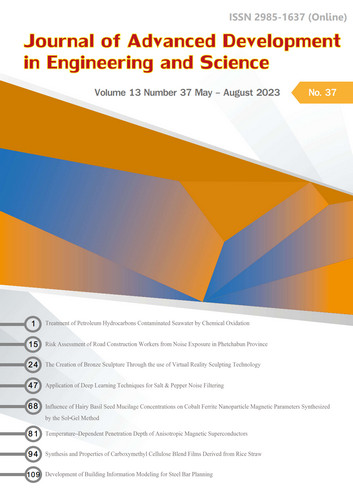การสังเคราะห์และสมบัติของฟิล์มผสมคาร์บอกซีเมทิลเซลลูโลส ที่ได้จากฟางข้าว
Main Article Content
บทคัดย่อ
งานวิจัยนี้ศึกษาการผลิตและสมบัติของฟิล์มคาร์บอกซีเมทิลเซลลูโลส (CMC) และฟิล์มผสมคาร์บอกซีเมทิลเซลลูโลสกับพอลิไวนิลแอลกอฮอล์ (CMC/PVA) โดยใช้ฟางข้าวเป็นวัตถุดิบ การสังเคราะห์ CMC จากฟางข้าวประกอบด้วย 2 ขั้นตอน ได้แก่ ขั้นที่ 1 การสกัดเซลลูโลสจากฟางข้าวโดยการกำจัดลิกนินด้วย NaOH และฟอกสีด้วย H2O2 ขั้นที่ 2 การสังเคราะห์ CMC จากเซลลูโลสด้วยกระบวนการอีเทอริฟิเคชันโดยใช้ NaOH และกรดโมโนคลอโรอะซิติก (MCA) ผลการวิจัยแสดงให้เห็นว่า CMC ที่สังเคราะห์โดยใช้สารละลาย NaOH ความเข้มข้น 30%w/v และ ปริมาณเซลลูโลสต่อ MCA เท่ากับ 1:1.4 มีระดับการแทนที่ของ CMC สูงสุด เท่ากับ 0.49 จากนั้นสังเคราะห์ฟิล์ม CMC และ CMC/PVA ที่ปริมาณ PVA มีค่า 12.5 – 50 % w/w ด้วยวิธีการหล่อขึ้นรูป จากการทดสอบสมบัติทางกายภาพของฟิล์มพบว่า เมื่อปริมาณ PVA เพิ่มขึ้นทำให้ฟิล์มมีความหนาลดลง แต่ความโปร่งใสและการละลายน้ำมีค่าเพิ่มขึ้น และฟิล์ม CMC/PVA มีค่าการซึมผ่านไอน้ำต่ำกว่าฟิล์ม CMC นอกจากนี้ผลการทดสอบสมบัติเชิงกลพบว่าการเติม PVA ส่งผลให้ฟิล์มมีความต้านทานแรงดึงเพิ่มขึ้น โดยฟิล์ม CMC/PVA(12.5) มีความต้านทานแรงดึงสูงสุด เท่ากับ 20 MPa เมื่อทดสอบการย่อยสลายของฟิล์มโดยการฝังดินพบว่าฟิล์ม CMC และ CMC/PVA สามารถย่อยสลายได้มากกว่า 50% ภายใน 10 วัน และฟิล์ม CMC/PVA(12.5) สามารถนำมาใช้เป็นถุงเพาะชำที่ย่อยสลายได้ทางชีวภาพ
Article Details

อนุญาตภายใต้เงื่อนไข Creative Commons Attribution-NonCommercial-NoDerivatives 4.0 International License.
เนื้อหาและข้อมูลในบทความที่ลงตีพิมพ์ใน Journal of Advanced Development in Engineering and Science ถือเป็นข้อคิดเห็นและความรับผิดชอบของผู้เขียนบทความโดยตรง ซึ่งกองบรรณาธิการวารสารไม่จำเป็นต้องเห็นด้วยหรือร่วมรับผิดชอบใดๆ
บทความ ข้อมูล เนื้อหา ฯลฯ ที่ได้รับการตีพิมพ์ในJournal of Advanced Development in Engineering and Science ถือเป็นลิขสิทธิ์ของ Journal of Advanced Development in Engineering and Science หากบุคคลหรือหน่วยงานใดต้องการนำทั้งหมดหรือส่วนหนึ่งส่วนใดไปเผยแพร่ต่อหรือเพื่อกระทำการใดๆ จะต้องได้รับอนุญาตเป็นลายลักษณ์อักษรจาก Journal of Advanced Development in Engineering and Scienceก่อนเท่านั้น
เอกสารอ้างอิง
Villegas, P. (2018). Challenges to Solve Our Plastic Waste Problems. Organic and Medicinal Chemistry International Journal, 7(3), 1-2.
Atiwesh, G., et al. (2021). Environmental impact of bioplastic use: A review. Heliyon, 7(9), 1-9.
Tufan, M., et al. (2016). Synthesis and characterization of carboxymethyl cellulose film from pistachio shell. International Journal of Advances in Science, Engineering and Technology, 4(1), 153 – 155.
Abdulhameed, A., et al. (2019). Microwave synthesis of Carboxymethylcellulose (CMC) from Rice Husk. IOSR Journal of Applied Chemistry, 12(12), 3 – 42.
Asl, S., et al. (2017). Synthesis and Characterization of Carboxymethyl Cellulose from Sugarcane Bagasse. Journal of Food Processing&Technology, 8(8), 1-6.
Huang, C., et al. (2017). Synthesis and characterization of carboxymethyl cellulose from various agricultural wastes. Cellulose Chemistry and Technology, 51(7-8), 665 – 672.
Pushpamalar, V., et al. (2006). Optimization of reaction conditions for preparing carboxymethyl cellulose from sago waste. Carbohydrate Polymers, 64, 312 – 318.
Rodsamran, P. & Sothornvit, R. (2020). Carboxymethyl cellulose from rice stubble waste. Songklanakarin Journal of Science and Technology, 42(2), 454 – 460.
Yildirim-Yalcin, M., et al. (2022). Recent advances in the improvement of carboxymethyl cellulose-based edible films. Trends in Food Science & Technology, 129, 179 – 193.
Suderman, N., et al. (2016). Effect of drying temperature on the functional properties of biodegradable CMC-based film for potential food packaging. International Food Research Journal, 23(3), 1075 -1084.
Sharma, D., et al. (2021). Preparation and characterization of rice husk derived cellulose and polyvinyl alcohol blended heat sealable packing film. Indian Journal of Chemical Technology, 28, 453 – 459.
Zhang, L., et al (2013). Preparation and Characterization of Carboxymethyl Cellulose/Polyvinyl Alcohol Blend Film as a Potential Coating Material. Polymer-Plastics Technology and Engineering, (52), 163 – 167.
Moraes, C., et al. (2014). Review of the rice production cycle: Byproducts and the main applications focusing on rice husk combustion and ash recycling. Waste Management & Research, 32(11), 1034-48.
Standard Test Method for Sodium Carboxymethylcellulose. Available from: https:// celluloseether.com/wp-content/uploads/2018/04/ASTM-D1439-03.pdf. Accessed date:
October 2022.
Standard Test Method for Tensile Properties of Thin Plastic Sheeting. Available from: https:// www.wewontech.com/testing-standards/190125019.pdf. Accessed date 27 April 2023.
Krishamurthy, A. & Amrikumar, P. (2019). Synthesis and characterization of eco-friendly bioplastic from low-cost plant resources. SN Applied Sciences, 1, 1432.
Othman, S., et al. (2017). Water sorption and water permeability properties of edible film made from potato peel waste. Food Science and Technology, 37(Suppl.1), 63 – 70.
Morán, J., et al. (2008). Extraction of cellulose and preparation of nanocellulose from sisal fibers. Cellulose, 15, 149 – 159.
Gupta, H., et al. (2020). Synthesis of biodegradable films obtained from rice husk and sugarcane bagasse to be used as food packaging material. Environmental Engineering an Resource, 25(4), 506-514.
Ibrahim, M., et al (2013). Evaluation of cellulose and carboxymethyl cellulose/ poly(vinyl alcohol) membranes. Carbohydrate Polymers, (95), 414-420.
Negim E. S. M, et al. (2014). Improving biodegradability of polyvinyl alcohol/starch blend films for packging application. International Journal of Basic and Applied Science, 3(3), 263 – 273.

